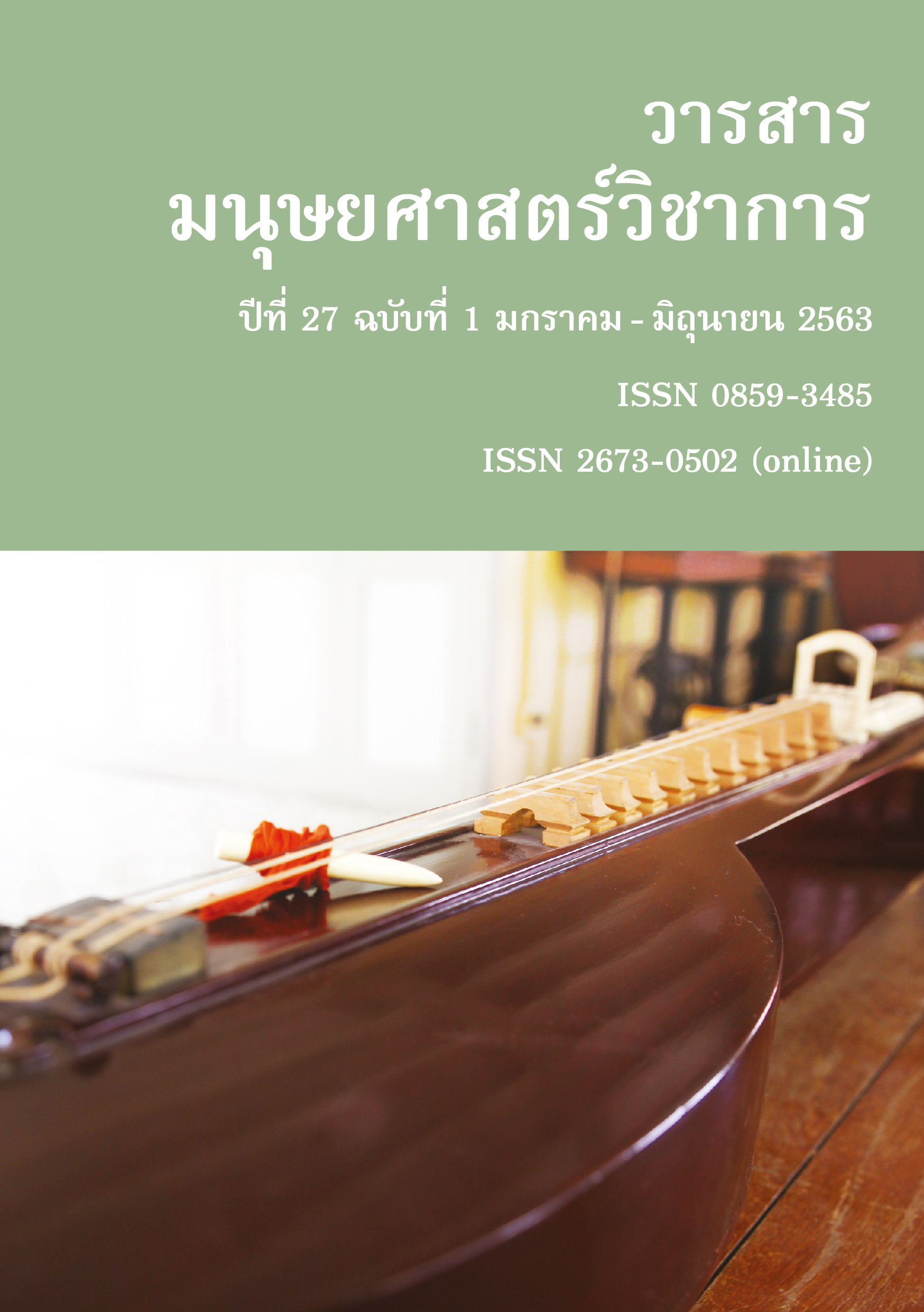Relationship between Vowel Quality and Vowel Space Size in Southeast Asian Languages
Main Article Content
Abstract
Vowel space is a boundary of resonant frequency in Acoustics Phonetics, which is a formant frequency that explains vowel quality. The r elationship between vowel quality and a vowel space size has been investigated by many researchers, but no one has described the relationship clearly.
The aims of the present work are to study and to compare the relationship between vowel quality and a vowel space size. The researcher hypothesized that vowel qualities (i.e. vowel length quality, oral-nasal quality, and register quality) were not related to a vowel space size.
The methods of this study were to investigate monophthongs of the five Southeast Asian languages (i.e. Pwo Karen, Saek, Mpi, Lamet, and Bru). The participants of the study were 15 males (3 males for each language). Praat program was used for recording sounds and analyzing acoustic data. Word lists were created based on the vowel inventory of each language. The five test tokens of each vowel were selected for acoustic analysis. The acoustic measurement of vowel focused on the first formant frequency (F1) and the second formant frequency (F2). The measurement value in Hertz of the formant frequencies was normalized by reducing the difference among speakers with the S-centroid vowel normalization. The vowel space size was calculated using the polygon space formula.
The results of study showed the relationship between vowel quality and a vowel space size in three main points. T he first point was that the vowel length quality did not correspond with the vowel space size, which did not support the hypothesis. As we can see, that the long vowel in Bru has larger vowel space size than the short vowel. The second point was that the oral-nasal quality did not correspond with the vowel space size. This supported the hypothesis in that oral vowels in some languages have a smaller vowel
space size than their nasal vowels, while oral vowels in some languages have a larger vowel space size than their nasal vowels. The third point was that the register quality did not correspond with the vowel space si ze, which supported the hypothesis. It could be noticed that modal-voiced vowels in some languages have both larger and smaller vowel space sizes than their creaky-voiced vowels. Likewise, modal-voiced vowels in some languages have both larger and smaller vowel space sizes than their breathy-voiced vowels.
Article Details
References
ธีระพัันธ์ เหลืองทองคำ และคณะ. (2554). เสีียงภาษาไทย: การศึกษาทางกลสัทศาสตร์. กรุงเทพฯ : จุฬาลงกรณ์มหาวิทยาลัย.
สุุภาพร ผลิพัฒน์. (2551). “ลัักษณะทางกลสัทศาสตร์ของเสียงสระ : กรณีศึกษาภาษาม้ง เมี่ยน และมัล” ใน นันทนา รณเกียรติ และอมร แสงมณี (บรรณาธิการ), รวมบทความภาษาศาสตร์เอเชียตะวันออกเฉียงใต้ เนื่องในโอกาสศาสตราจารย์ ดร. ธีระพันธ์ เหลืองทองคำมีอายุครบ 60 ปี. กรุงเทพฯ : ภาควิชาภาษาศาสตร์ คณะอักษรศาสตร์ จุฬาลงกรณ์มหาวิทยาลัย.
Abercrombie, David. (1967). Elements of General Phonetics. Edinburgh :Edinburgh University Press.
Abramson, A. S. (1962). The Vowels and Tone of Standard Thai: Acoustical Measurements and Experiments. Ann Arbor: University Microfilms International.
Abramson, A. S. , L-Thongkum, T. and Nye P. W. (2004). “Voice register in Suai (Kuai): an analysis of perceptual and acoustic data”. In Phonetica, Vol. 61, pp. 147-171.
Abramsom, A. S. and Ren, N. (1990). “Distinctive vowel length: duration versus spectrum in Thai”. In Journal of Phonetics 18: p. 79-92.
Al-Tamimi, J. E. and Ferragne, E. (2005). “Does vowel space size depend on language vowel inventories? Evidence from two Arabic dialects and French”. In Interspeech Proc, pp. 2495-2498. Lisbon.
Gendrot, C. and Adda-Decker, M. (2007). “Impact of duration and vowel inventory size on formant values of oral vowels: An automated formant analysis from eight languages”. In ICPhS XVI Proc., pp. 1417-1420. Saarbrucken.
Ladefoged, Peter. (2001). A Course in Phonetics. (4th ed.). Orlando: Harcourt College Publishers.
Theraphan L-Thongkum. (1988a). “Another look at the register distinction in Mon”, In Cholthicha Bamroongrak et.al. (eds) Proceedings of the International Symposium on Language and Linguistics, (pp. 22-51). Bangkok: Thammasat University.
Theraphan L-Thongkum. (1988b). “Phonation types in Mon-Khmer languages”. In Fujimura, Osamu (ed) Vocal Fold Physiology 2 : Voice Production, Mechanisms and Functions (pp. 319-333). NY: Raven Press.
Theraphan L-Thongkum. (1989). “An acoustic study of the register complex in Kui (Suai)”. Mon Khmer Studies Journal, 15, pp. 1-19.
Theraphan L-Thongkum. (1991). “An Instrumental study of Chong registers”. In Davidson, J.H.C.S. (ed) Austroasiatic Languages : Essay in Honour of H.L. Shorto (pp. 141-160). London: SOAS.
Watt, D. J. L., Fabricius, A.H., and Johnson, D. E. (2009). “A comparison of three speaker-intrinsic vowel formant frequency normalization algorithms for sociophonetics”. In Language Variation and Change
(3), pp. 413-435.


